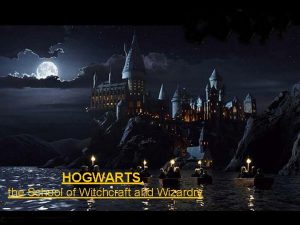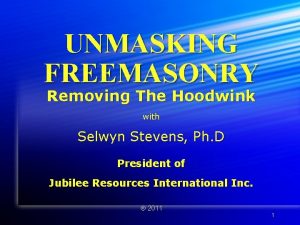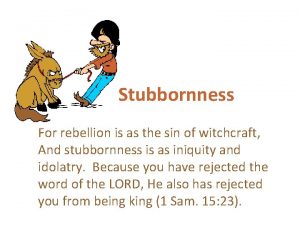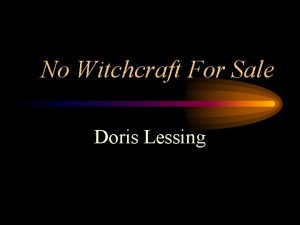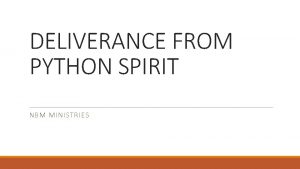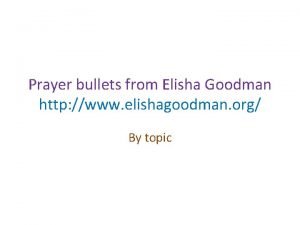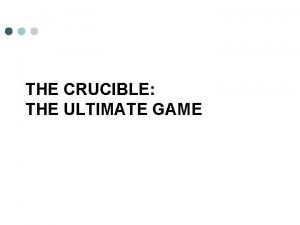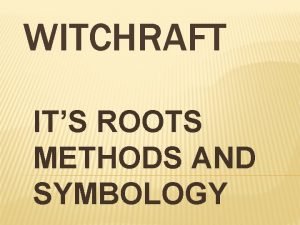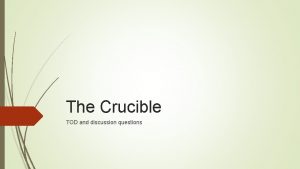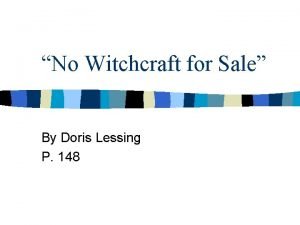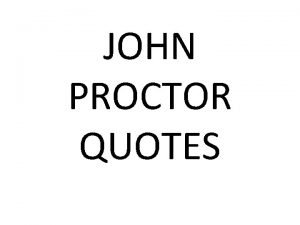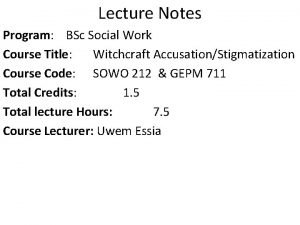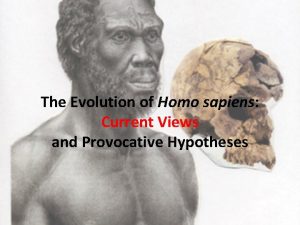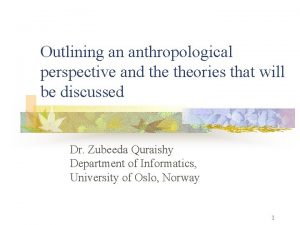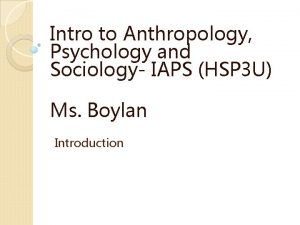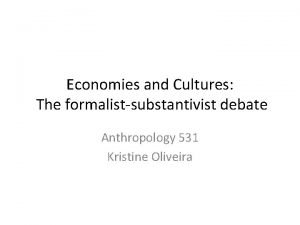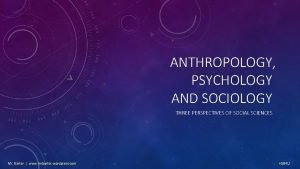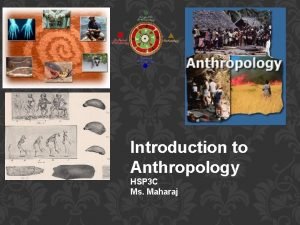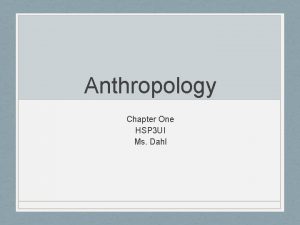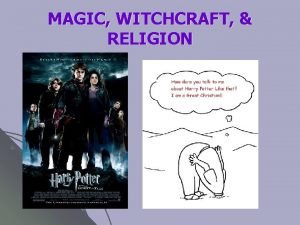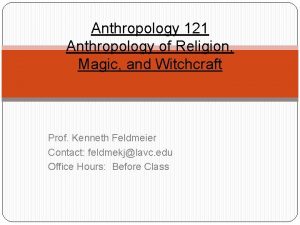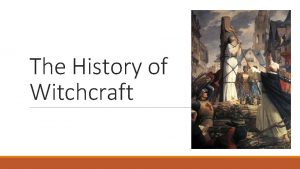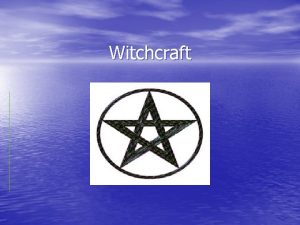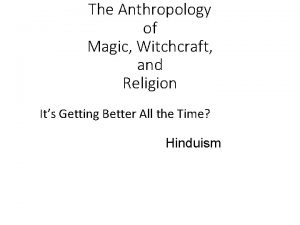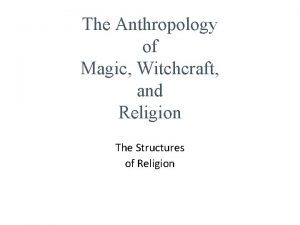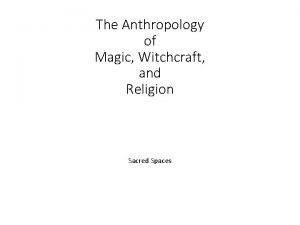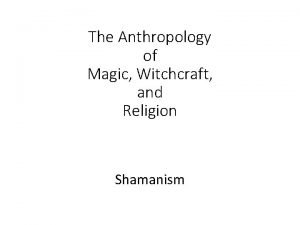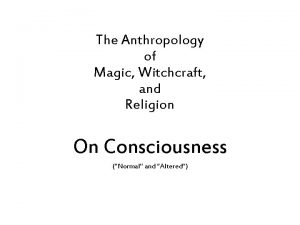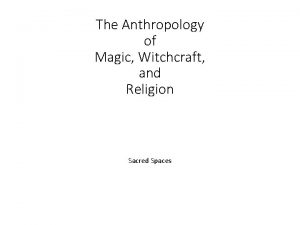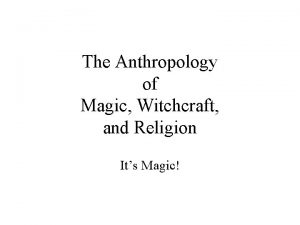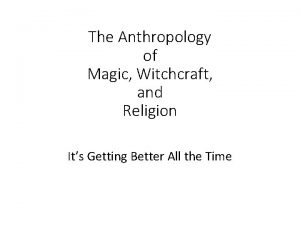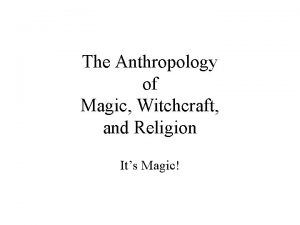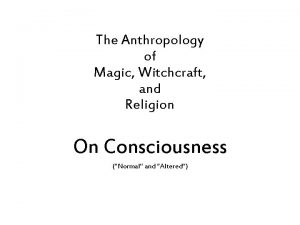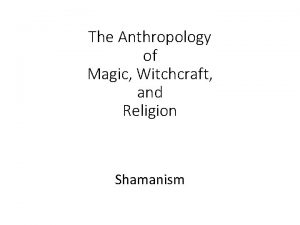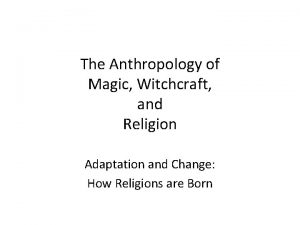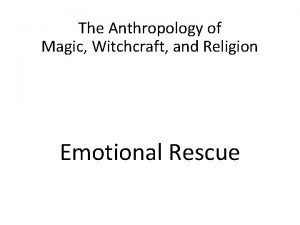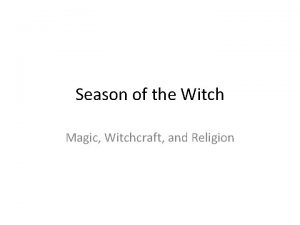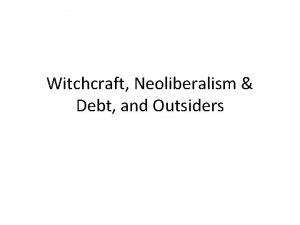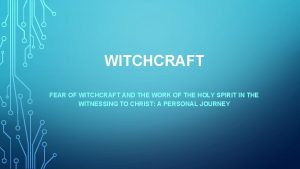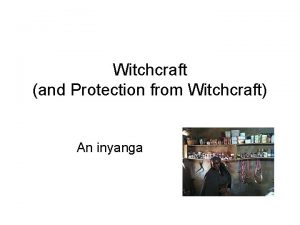The Anthropology of Magic Witchcraft and Religion On







































- Slides: 39

The Anthropology of Magic, Witchcraft, and Religion On Consciousness (“Normal” and “Altered”)

Conscious First use in the early 1600 s; derived from Latin conscius com- “with” + scire “to know” Thus: “knowing with others, participating in knowledge, aware of” Consciousness: the ability to know about – and consequently to act within – the world.

“knowing with others, participating in knowledge, aware of” • This is not as straightforward as it might seem… • Can I be certain that what I know is what you know? • Can I really “participate” in your knowledge? • What does it mean to be “aware”?

How can I know what is going on inside of someone else’s head? (assuming anything is going on at all? )

One Answer Ban Consciousness as a Topic of Study John B. Watson 1878 -1958 Burrhus Fredric Skinner 1904 -1990 The “fathers” of behaviorism

The Behaviorist Answer black box Stimulus Response But what is going on inside the cat’s head? that is… Why does it respond the way it does?

A range of answers… Panpsychism Solipsism all matter has some form of consciousness one’s own mind is all that exists

But things change (as they always do…) Albert Hofmann 1906 -2008 Holding a model of the LSD molecule Allen Ginsburg 1926 -1997 dancing at the Human Be-In, 1967 and “consciousness” has made a come-back

Waking States of Consciousness • Enable an organism to function within the world • Primarily outward directed • Survival-oriented (identifying food, enemies, mates, etc. )

For us… • Consciousness involves the ability to know about – and consequently to act within – the world. • Involves “self-awareness” – found in • humans • chimps • gorillas • i. e. , of the self as being distinct from the rest of the universe

The “Mirror Test”

A Measure of Self-Awareness “passed” by: • great apes – – • • • Bonobos Chimpanzees Orangutans Gorillas Bottlenose Dolphins Orcas Elephants European Magpies Pigs Humans (after app. 18 months) Don’t worry, they’re just friends…

Consciousness Is made possible by biological processes that are • open to manipulation • culturally defined Therefore, “normal consciousness” will differ from society to society

Mind is a “high level” function of the brain that • Enables self-awareness • Allows the individual to conceptualize her or his place in the world • Makes it possible to learn, generate, and apply “high level” models of the world

Models are Learned Via • Observation • Experience • Language (at least in humans)

Learned Models • Hypotheses about the world – verified or falsified through sensory and motor activity • Unique to individual (non-isomorphic) • Limited in scope and applicability (tenuous)

Sensory Input • We learn how to refer to things (through language) • We learn what things in the world are (culturally) significant • We learn how to act upon the world

Motor Output • Is how we act within and upon the world • Is how we verify the “correctness” of our consensual models of the world

Normal “States” of Consciousness • Waking Mode (the “baseline”) • Deep Sleep • REM (Dream) Sleep

Altered States of Consciousness

Altered “States” of Consciousness aka Mystical Transcendental Transpersonal Integrative

ASCs Can be induced at several “levels” • Body/Brain functioning • Mental Activity • External agents

How to Induce ASCs Sensory Activity deprivation overload Mental Activity focused relaxed

Inducing ASCs • Reduce sensory input and/or motor output • Increase sensory input and/or motor output and/or emotion • Increase mental alertness or involvement • Decrease mental alertness and/or relax critical faculties • Change body chemistry and/or neurophysiological functioning

The Continuum of Consciousness States (Roland Fischer)

In an “Altered State” • A person may be unable to determine whether their experiences relate to events outside the body/brain • Learned models about the external world are detached from the possibility of verification

In an “Altered State” • Conflicting models (“mental tectonic plates”) may result in “seismic” events • Depending upon context and cultural values, these events may be interpreted as – Positive – Neutral – Negative

Cultures and ASCs • Each culture defines which ASCs are allowed and which are not • Every culture fails to recognize most of the ASCs that humans can experience • ASCs – and therewith the dimensions of human experience – and shaped by culture

Cultures and “Drugs” • Ritualized drug use – culturally explained, tend to be integrative • Proscribed drug use – individually shaped, may be dis/integrative (both to the individual and the culture)

Balche’ Ritual of the Lacandon Maya • Made from a tree (Lonchocarpus violaceus) that is allow to ferment • Active components: alcohol, longistylines • Rite of Intensification (collective use)

Peyote Use among the Huichol • Peyote cactus (Lophophora williamsii) contains mescaline and numerous other alkaloids • Used as an all purpose medicine and for ritual purposes

Datura Use among the Chumash • Datura wrightii contains numerous tropane alkaloids (atropine, scopolamine) • Used in initiations, to acquire spirit helpers

Hoasca/Ayahuasca Banisteriopsis caapi Psychotria viridis

Caapi contains β-carbolines Sedative Hypnotic MAO-inhibiting Chacruna contains Dimethyltryptamines Visionary

Ayahuasca • Use for millennia in Amazon Basin and neighboring regions • May be the most commonly used hallucinogenic preparation in the world

Ayahuasca Churches Santo Daime • Founded in 1920 s by Raimundo Irineu Serra • Combines Christian with indigenous & Mestizo religious elements

Ayahuasca Churches União de Vegetal • Founded in 1961 by Jose Gabriel da Costa (Mestre Gabriel) • UDV Church has U. S. presence

Ayahuasca Tourism

What can we say about Consciousness? • It is dynamic • It is different for each of us • All cultures control the consciousness of their members • Your consciousness is your most personal attribute
 Hufflepuff first year timetable
Hufflepuff first year timetable Western religion vs eastern religion
Western religion vs eastern religion Freemason hierarchy
Freemason hierarchy Spirit of rebellion and stubbornness
Spirit of rebellion and stubbornness Story of gideon summary
Story of gideon summary Python spirit deliverance
Python spirit deliverance Elisha goodman prayers against rejection
Elisha goodman prayers against rejection What is parris's position in salem
What is parris's position in salem Witchcraft symbology
Witchcraft symbology American academy of witchcraft arts
American academy of witchcraft arts The crucible act one discussion questions
The crucible act one discussion questions No witchcraft for sale
No witchcraft for sale John proctor quote
John proctor quote Bsc witchcraft
Bsc witchcraft No witchcraft for sale summary
No witchcraft for sale summary Lumpers and splitters anthropology
Lumpers and splitters anthropology Introduction of anthropology
Introduction of anthropology Introduction to anthropology psychology and sociology
Introduction to anthropology psychology and sociology Substantivism vs formalism
Substantivism vs formalism Sociology psychology and anthropology venn diagram
Sociology psychology and anthropology venn diagram Hsp 3c
Hsp 3c Introduction to anthropology psychology and sociology
Introduction to anthropology psychology and sociology Anthropology and its branches
Anthropology and its branches Hát kết hợp bộ gõ cơ thể
Hát kết hợp bộ gõ cơ thể Ng-html
Ng-html Bổ thể
Bổ thể Tỉ lệ cơ thể trẻ em
Tỉ lệ cơ thể trẻ em Gấu đi như thế nào
Gấu đi như thế nào Thang điểm glasgow
Thang điểm glasgow Bài hát chúa yêu trần thế alleluia
Bài hát chúa yêu trần thế alleluia Môn thể thao bắt đầu bằng từ đua
Môn thể thao bắt đầu bằng từ đua Thế nào là hệ số cao nhất
Thế nào là hệ số cao nhất Các châu lục và đại dương trên thế giới
Các châu lục và đại dương trên thế giới Công của trọng lực
Công của trọng lực Trời xanh đây là của chúng ta thể thơ
Trời xanh đây là của chúng ta thể thơ Mật thư anh em như thể tay chân
Mật thư anh em như thể tay chân 101012 bằng
101012 bằng Phản ứng thế ankan
Phản ứng thế ankan Các châu lục và đại dương trên thế giới
Các châu lục và đại dương trên thế giới Thơ thất ngôn tứ tuyệt đường luật
Thơ thất ngôn tứ tuyệt đường luật
